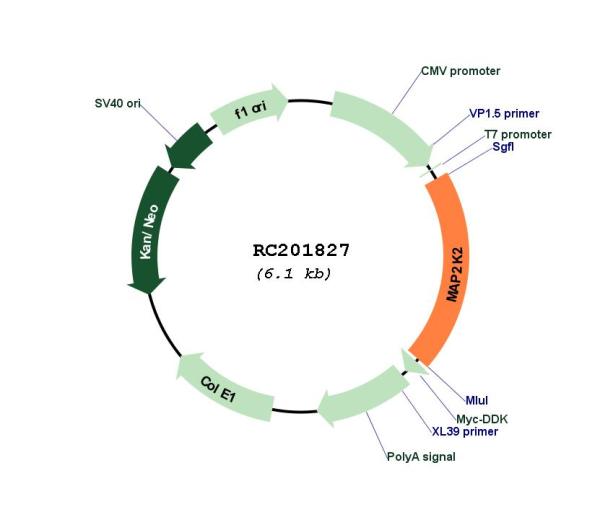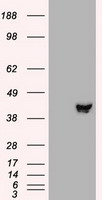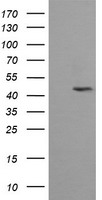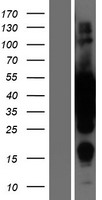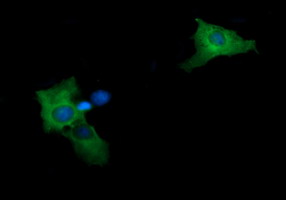MEK2 (MAP2K2) (NM_030662) Human Tagged ORF Clone
CAT#: RC201827
MAP2K2 (Myc-DDK-tagged)-Human mitogen-activated protein kinase kinase 2 (MAP2K2)
ORF Plasmid: tGFP
"NM_030662" in other vectors (7)
Need custom modification / cloning service?
Get a free quote
CNY 3,656.00
CNY 3,990.00
| Cited in 1 publication. |
CNY 300.00
CNY 1,999.00
CNY 2,700.00
Specifications
| Product Data | |
| Type | Human Tagged ORF Clone |
| Tag | Myc-DDK |
| Synonyms | CFC4; MAPKK2; MEK2; MKK2; PRKMK2 |
| Vector | pCMV6-Entry |
| E. coli Selection | Kanamycin (25 ug/mL) |
| Mammalian Cell Selection | Neomycin |
| Sequence Data |
>RC201827 representing NM_030662
Red=Cloning site Blue=ORF Green=Tags(s) TTTTGTAATACGACTCACTATAGGGCGGCCGGGAATTCGTCGACTGGATCCGGTACCGAGGAGATCTGCC GCCGCGATCGCC ATGCTGGCCCGGAGGAAGCCGGTGCTGCCGGCGCTCACCATCAACCCTACCATCGCCGAGGGCCCATCCC CTACCAGCGAGGGCGCCTCCGAGGCAAACCTGGTGGACCTGCAGAAGAAGCTGGAGGAGCTGGAACTTGA CGAGCAGCAGAAGAAGCGGCTGGAAGCCTTTCTCACCCAGAAAGCCAAGGTCGGCGAACTCAAAGACGAT GACTTCGAAAGGATCTCAGAGCTGGGCGCGGGCAACGGCGGGGTGGTCACCAAAGTCCAGCACAGACCCT CGGGCCTCATCATGGCCAGGAAGCTGATCCACCTTGAGATCAAGCCGGCCATCCGGAACCAGATCATCCG CGAGCTGCAGGTCCTGCACGAATGCAACTCGCCGTACATCGTGGGCTTCTACGGGGCCTTCTACAGTGAC GGGGAGATCAGCATTTGCATGGAACACATGGACGGCGGCTCCCTGGACCAGGTGCTGAAAGAGGCCAAGA GGATTCCCGAGGAGATCCTGGGGAAAGTCAGCATCGCGGTTCTCCGGGGCTTGGCGTACCTCCGAGAGAA GCACCAGATCATGCACCGAGATGTGAAGCCCTCCAACATCCTCGTGAACTCTAGAGGGGAGATCAAGCTG TGTGACTTCGGGGTGAGCGGCCAGCTCATAGACTCCATGGCCAACTCCTTCGTGGGCACGCGCTCCTACA TGGCTCCGGAGCGGTTGCAGGGCACACATTACTCGGTGCAGTCGGACATCTGGAGCATGGGCCTGTCCCT GGTGGAGCTGGCCGTCGGAAGGTACCCCATCCCCCCGCCCGACGCCAAAGAGCTGGAGGCCATCTTTGGC CGGCCCGTGGTCGACGGGGAAGAAGGAGAGCCTCACAGCATCTCGCCTCGGCCGAGGCCCCCCGGGCGCC CCGTCAGCGGTCACGGGATGGATAGCCGGCCTGCCATGGCCATCTTTGAACTCCTGGACTATATTGTGAA CGAGCCACCTCCTAAGCTGCCCAACGGTGTGTTCACCCCCGACTTCCAGGAGTTTGTCAATAAATGCCTC ATCAAGAACCCAGCGGAGCGGGCGGACCTGAAGATGCTCACAAACCACACCTTCATCAAGCGGTCCGAGG TGGAAGAAGTGGATTTTGCCGGCTGGTTGTGTAAAACCCTGCGGCTGAACCAGCCCGGCACACCCACGCG CACCGCCGTG ACGCGTACGCGGCCGCTCGAGCAGAAACTCATCTCAGAAGAGGATCTGGCAGCAAATGATATCCTGGATT ACAAGGATGACGACGATAAGGTTTAA >RC201827 representing NM_030662
Red=Cloning site Green=Tags(s) MLARRKPVLPALTINPTIAEGPSPTSEGASEANLVDLQKKLEELELDEQQKKRLEAFLTQKAKVGELKDD DFERISELGAGNGGVVTKVQHRPSGLIMARKLIHLEIKPAIRNQIIRELQVLHECNSPYIVGFYGAFYSD GEISICMEHMDGGSLDQVLKEAKRIPEEILGKVSIAVLRGLAYLREKHQIMHRDVKPSNILVNSRGEIKL CDFGVSGQLIDSMANSFVGTRSYMAPERLQGTHYSVQSDIWSMGLSLVELAVGRYPIPPPDAKELEAIFG RPVVDGEEGEPHSISPRPRPPGRPVSGHGMDSRPAMAIFELLDYIVNEPPPKLPNGVFTPDFQEFVNKCL IKNPAERADLKMLTNHTFIKRSEVEEVDFAGWLCKTLRLNQPGTPTRTAV TRTRPLEQKLISEEDLAANDILDYKDDDDKV |
| Chromatograms |
CHROMATOGRAMS
 Sequencher program is needed, download here. |
| Restriction Sites |
SgfI-MluI
Cloning Scheme for this gene
Plasmid Map

|
| ACCN | NM_030662 |
| ORF Size | 1200 bp |
| OTI Disclaimer | The molecular sequence of this clone aligns with the gene accession number as a point of reference only. However, individual transcript sequences of the same gene can differ through naturally occurring variations (e.g. polymorphisms), each with its own valid existence. This clone is substantially in agreement with the reference, but a complete review of all prevailing variants is recommended prior to use. More info |
| OTI Annotation | This clone was engineered to express the complete ORF with an expression tag. Expression varies depending on the nature of the gene. |
| Product Components | The ORF clone is ion-exchange column purified and shipped in a 2D barcoded Matrix tube containing 10ug of transfection-ready, dried plasmid DNA (reconstitute with 100 ul of water). |
| Reconstitution | 1. Centrifuge at 5,000xg for 5min. 2. Carefully open the tube and add 100ul of sterile water to dissolve the DNA. 3. Close the tube and incubate for 10 minutes at room temperature. 4. Briefly vortex the tube and then do a quick spin (less than 5000xg) to concentrate the liquid at the bottom. 5. Store the suspended plasmid at -20°C. The DNA is stable for at least one year from date of shipping when stored at -20°C. |
| Note | Plasmids are not sterile. For experiments where strict sterility is required, filtration with 0.22um filter is required. |
| Reference Data | |
| RefSeq | NM_030662.2, NP_109587.1 |
| RefSeq Size | 1759 bp |
| RefSeq ORF | 1203 bp |
| Locus ID | 5605 |
| UniProt ID | P36507 |
| Domains | pkinase, TyrKc, S_TKc |
| Protein Families | Druggable Genome, Protein Kinase |
| Protein Pathways | Acute myeloid leukemia, B cell receptor signaling pathway, Bladder cancer, Chronic myeloid leukemia, Endometrial cancer, ErbB signaling pathway, Fc epsilon RI signaling pathway, Gap junction, Glioma, GnRH signaling pathway, Insulin signaling pathway, Long-term depression, Long-term potentiation, MAPK signaling pathway, Melanogenesis, Melanoma, Natural killer cell mediated cytotoxicity, Neurotrophin signaling pathway, Non-small cell lung cancer, Pathways in cancer, Prion diseases, Prostate cancer, Regulation of actin cytoskeleton, Renal cell carcinoma, T cell receptor signaling pathway, Thyroid cancer, Toll-like receptor signaling pathway, Vascular smooth muscle contraction, VEGF signaling pathway |
| MW | 44.2 kDa |
| Gene Summary | The protein encoded by this gene is a dual specificity protein kinase that belongs to the MAP kinase kinase family. This kinase is known to play a critical role in mitogen growth factor signal transduction. It phosphorylates and thus activates MAPK1/ERK2 and MAPK2/ERK3. The activation of this kinase itself is dependent on the Ser/Thr phosphorylation by MAP kinase kinase kinases. Mutations in this gene cause cardiofaciocutaneous syndrome (CFC syndrome), a disease characterized by heart defects, cognitive disability, and distinctive facial features similar to those found in Noonan syndrome. The inhibition or degradation of this kinase is also found to be involved in the pathogenesis of Yersinia and anthrax. A pseudogene, which is located on chromosome 7, has been identified for this gene. [provided by RefSeq, Jul 2008] |
Citations (1)
| The use of this cDNA Clones has been cited in the following citations: |
|---|
|
Interaction of tRNA with MEK2 in pancreatic cancer cells
,Wang, X;Chow, CR;Ebine, K;Lee, J;Rosner, MR;Pan, T;Munshi, HG;,
Sci Rep
,PubMed ID 27301426
[MEK2]
|
Documents
| Product Manuals |
| FAQs |
| SDS |
Resources
Other Versions
| SKU | Description | Size | Price |
|---|---|---|---|
| RC201827L1 | Lenti ORF clone of Human mitogen-activated protein kinase kinase 2 (MAP2K2), Myc-DDK-tagged |
CNY 6,056.00 |
|
| RC201827L2 | Lenti ORF clone of Human mitogen-activated protein kinase kinase 2 (MAP2K2), mGFP tagged |
CNY 5,890.00 |
|
| RC201827L3 | Lenti ORF clone of Human mitogen-activated protein kinase kinase 2 (MAP2K2), Myc-DDK-tagged |
CNY 6,056.00 |
|
| RC201827L4 | Lenti ORF clone of Human mitogen-activated protein kinase kinase 2 (MAP2K2), mGFP tagged |
CNY 6,056.00 |
|
| RG201827 | MAP2K2 (tGFP-tagged) - Human mitogen-activated protein kinase kinase 2 (MAP2K2) |
CNY 5,256.00 |
|
| SC110003 | MAP2K2 (untagged)-Human mitogen-activated protein kinase kinase 2 (MAP2K2) |
CNY 3,656.00 |
|
| SC323627 | MAP2K2 (untagged)-Kinase deficient mutant (K101M) of Human mitogen-activated protein kinase kinase 2 (MAP2K2) |
CNY 3,656.00 |


 United States
United States
 Germany
Germany
 Japan
Japan
 United Kingdom
United Kingdom
 China
China

